Data Analysis and Discussion
The present section is organized into two parts: the analysis of the quantitative and qualitative data. The analysis of the quantitative data seeks to answer whether color coding was of any use for enhancing memory retention in students. The first part of the results section interprets the data and visualizes the findings in a comprehensive and understandable way. The second part of the results section deals with the materials drawn from six interviews with students from the intervention group. The analysis of the quantitative data provides insights into the emotional perception of the method by students as well as their preferences in color-coding.
Quantitative Data Analysis. What is the effect of color-coding on memory retention in students learning English as a second language?
The quantitative data collected for the research entails the test results of two groups of students – control and intervention with the latter being subjected to the color-coding method. The control group consisted of 31 participants whereas the sample for intervention turned out to be somewhat larger – at 51 participants. The evaluation was conducted three times – before the lesson, right after it, and with a one-month delay.
The data collection resulted in six sets of data – three data sets per group that later were subject to comparison through a variety of statistical methods. The first step toward data interpretation was analyzing the results with the purpose of determining the inner consistency and reliability. One of the methods used was computing Cronbach’s alpha – a commonly known statistical measure demonstrating how consistent the results are and whether they describe the same object of scientific inquiry. As seen from Table 1, Cronbach’s alpha is at 0.627 (N=10), the value is positive and close to 1, which denotes a decent inner consistency.
The metric is even better when Cronbach’s alpha based on standardized items is used (0.801, N=10), which might be a more appropriate measure for the present study given the changing response option of the scale used. Image 1 provides the inter-item correlation matrix with the majority of values fitting into the interval [0.25, 0.5], which once again confirms the inner consistency of the test and test results.
Table 1. Cronbach’s Alpha.

The next step was to explore the data for normality, computing its mean values and standard deviation (Table 2). The label “color” denotes the intervention group whereas “no-color” – the control group. To gauge the effect size, the minimum, maximum, and range values were also calculated for both groups (Table 3).
Table 2. Test results, their mean values and standard deviation.
Table 3. Test results, minimum, maximum, and range values.
As seen from Table 1, both control and intervention groups had comparably similar mean values and standard deviation. This shows the researchers that random assignment at two groups to minimize bias was successful, as groups proved to be more or less homogenous (Graph 1). In Graph 1, the two histograms overlap, showing that the initial results before the second group was subjected to the intervention were similar. Had it been the other way around, one would have had the right to speculate that group constitution was skewed from the start, as in one group might have had stronger or more knowledgeable learners. If the latter were the case, the intervention effect would have been mitigated and, hence, fairly dubious.
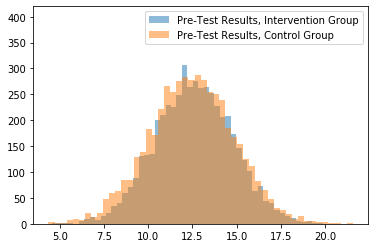
Graph 1 and Graph 2 demonstrate the results in the form of a histogram with the probability density function overlayed to show how the histogram fits the bell curve. Neither the control group nor the intervention group fits the graph of the probability density function (the bell curve). If the pre-test results had been normally distributed, the majority of the students would have scored around 12. It is true that the outliers (extremely low and extremely high scores) fit the probability density function in both cases, which is seen as standard. Yet, in both groups, the majority of students scored higher than average (13-15). It is hard to say exactly what accounts for this curious phenomenon. One possible explanation is that students in both groups already had decent background knowledge allowing them to show outstanding performance.
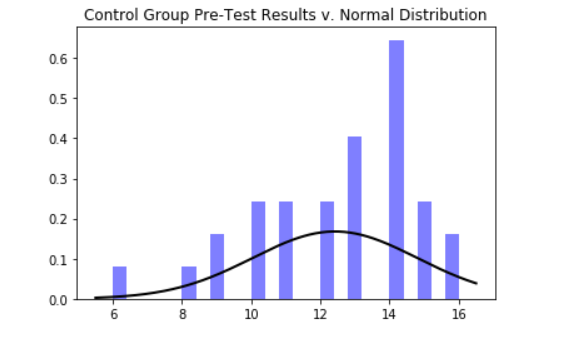
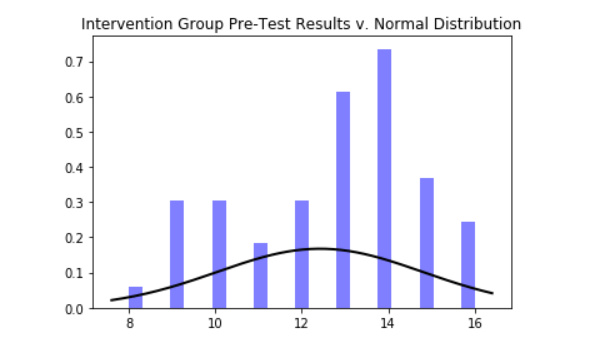
The next step was to measure the effect size of the intervention by putting together three Gaussian distribution graphs next to each other on the same plot (Graph 3 and Graph 4). By the shape of the histograms plotted on Graph 3, one may conclude that the intervention had a tangible positive effect. The distributions for pre-test and post-test results (in blue and orange respectively) barely overlap as the mean test score increased significantly after the color coding was introduced. Moreover, after the intervention, the color group showed a smaller standard deviation in results than they did before.
This change means that “weaker” students were able to make progress and decrease the difference between their scores and those of the “stronger students.” The green histogram represents the Gaussian distribution of the delayed post-test results. Expectedly, the intervention group experienced a setback in test scores (the histogram located to the left of that denoting the test results right after the intervention). Yet, as seen from Graph 3, the setback is not serious as it still barely overlaps with the graph representing the initial results. However, the graph denoting the delayed results is less steep than the one denoting the immediate results. This difference means that after a delay, the student group showed more diverse performance, allowing for worse scores than right after the intervention.
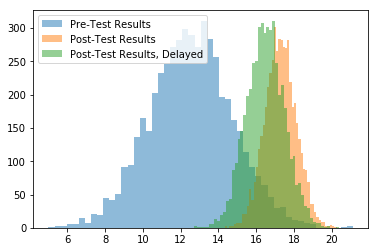
Graph 4 is similar to Graph 3 and represents the results drawn from the control group. As seen from Graph 4, the control group has shown some improvement after being taught the new topic traditionally (the mean range is a positive value). The progress is evident since the graph representing the immediate results (in orange) is farther from the left than the one representing the initial results (blue) (Vogt, 2007).
Moreover, the histogram in orange is steeper than the one in blue, demonstrating fewer outliers and more concentrated around the mean axis. This tendency means that after being taught the new topic, the students in the control group showed stably higher-than-average results. After a one-month delay, the control group experienced a certain setback, with the green graph (delayed results) almost overlapping with the blue one (initial results). Moreover, after one month, the students showed more diverse performance, allowing for both lower and higher scores.
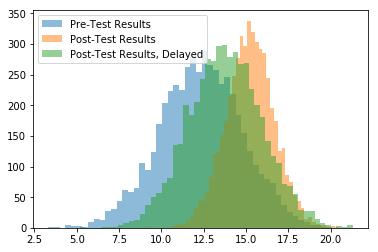
After seeing the dynamics within the two groups separately, it is reasonable to ask how these results compare to each other. So far it was possible to observe pretty similar dynamics: a lesson in articles would prompt students to make some progress, no matter the teaching method. After some time, however, regardless of the assigned group, students would experience a setback. To better understand how the two group dynamics compare and contrast, the results were visualized separately. As seen from Graph 5, the intervention group showed far better results than the control group. Moreover, the students in the intervention group showed steadily high performance with the scores concentrated mainly around the mean of the distribution. The same goes for Graph 6: after a one-month delay, the students in the intervention group were more capable of retaining the information and scoring higher than their counterparts in the control group.
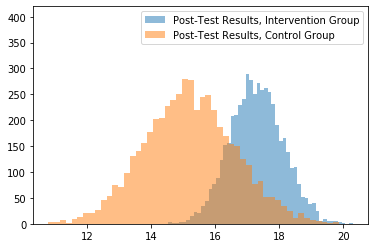
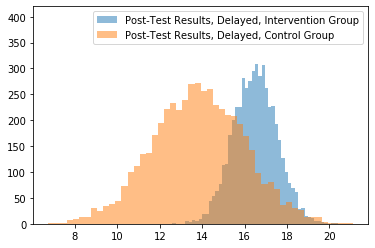
Lastly, to confirm what has been said, the data were analyzed using Student’s t-test. For the pre-test results, the method showed similarity between the two independent samples (t = 0.556, df = 81), which is consistent with Graph 4. In the same manner, the post-test results proved to be dissimilar (t = 8.021, df = 81), which may also be seen from Graph 5. Lastly, Student’s t-test showed a significant discrepancy when it comes to the delayed post-test results (t = 7.5, df = 80).
Summary
The pre-test results have shown somewhat peculiar results distribution with the majority of data points concentrated past the mean axis. One may assume that the students both in the intervention and control groups had already been showing pretty good results before being tested on a new topic. The color-coding intervention seems to have yielded positive results with the intervention group showing much more progress than their counterparts in the control group. Besides, the group that was exposed to the color-coding method managed to retain more information and score higher after a one-month delay.
Qualitative Data Analysis. What is the participants’ perception of the color-coding method? Is using color more preferable than black-and-white schemes?
The purpose of the qualitative part of the research was to gain deeper insights into the participants’ perception of the color-coding method. It is true that quantitative data may be more objective when gauging the efficiency of a strategy. However, figures and numbers often fail to embark on the psychological aspect of the learning process, which cannot and should not be dismissed. Moreover, pre-, post, and delayed test results did not provide the researchers with straightforward practical implications aside from the overall promising prospects of the method. The unstructured interview (response rate = 9%) sought to confirm that students understood why and how the method was used. Among other goals were gaining an understanding of their subjective perception and whether they attributed the color-coding to their improved performance.
Coding: colored vs. Black and White
After the analysis of the qualitative data, it has become possible to fill in one of the main knowledge gaps outlined in the literature review. The question was as to whether color-coding using real, chromatic colors presented any benefits as opposed to using only black and white. Having interviewed six students from the intervention group, one may conclude that they were overwhelmingly in support of the color incorporation (100%). According to the statistical data provided by NVivo, references to the choice between the colored and black and white presentation of materials have amounted to a total of 8% of the coverage. Interestingly enough, when explaining exactly why they liked the use of color, participants made clear associations with other themes singled out in qualitative data.
For instance, Participant 1 tied his preferences to his personal impressions and helpfulness of the new method: “Of course I like it to be more colorful like I said before, it helps me to remember the important stuff and focus on them and make studying easier for me and more effective, it was really useful.” As seen from the citation, Participant 1 specified exactly why the method was helpful, focusing on the ease of learning and enhanced memory retention. These observations are in line with what other participants reported regarding their remembering faculties: “The colors helped me focus more on the main idea. And helped me in recalling them and going back at the slides in my mind.”
Participant 2 was also in favor of the color-coding method, appraising it for its ability to help to concentrate: “It helps me focus on the information more than when black ink is used and it stands out more.” Further, they added that the color-coding helped to maintain the consistency and flow of the learning materials, which was another common theme encoded via NVivo: “When color coding is used in both lectures and tests, it helps you think of them together.”
Another participant pointed out how logically the new learning materials were organized. They argued that the color-coding might have as well been done wrong if too many colors had been used at once. In this case, students would have to understand the color-coding system in detail before embarking on a task. The use of color for this research proved to be sufficient and not distracting as stated by the said participant: “If you can just make it all black, red, green, they’ll get interested in it but they don’t understand it cause they’re trying to find the word like where it cause if you put like highlighted colors it would like they’ll know it better cause they can see it.”
Interestingly enough, the color-coding helped not only with keeping the lesson consistent but preparing the students for what is coming next: “I think using colors are more effective because it helped me know what’s going on and even before you teach the lessons sometimes and it helps you understand it more.” Lastly, one of the interviewees drew parallels between color-coding and other methods aimed at drawing students’ attention: “Yeah I think it’s more helpful in memory and in drawing the attention and You can also underline, Bold, Italics they are kinda like color coding.” In summation, according to the interview materials, colors are perceived better than achromatic schemes (black and white).
Helpfulness
Probably the overarching concept discovered when encoding the interviews is that of helpfulness (10% of the total coverage according to NVivo). This result may be seen as positive as the concept of helpfulness may point one to the references regarding memory retention, which is the central question of the present research. Helpfulness is a broad concept that entails several sub-themes defined as follows (see Image 1).
Consistency
One of the minor themes that were possible to outline via NVivo was that of consistency (1% of coverage). In the context of the learning process, consistency can be operationalized as the harmony and balance of all elements allowing for better comprehension. Participants were not asked directly as to whether they thought that color-coding made the lesson more consistent. Instead, they provided the insights independently, for example: “The layout of the lecture was the same from start to finish.” Another participant complimented the flow: “It really made the presentation flow nicely.” Lastly, one more interviewee reported on the wholeness of the experience thanks to the color-coding method: “ [color-coding helped me] concentrate more on the lecture as a whole.”
Focus. Another significant topic within the helpfulness theme is the focus. Participants provided the following answers regarding the subtopic:
- The colors helped me focus more on what the question was asking;
- The contrast between the black and red print also helped me look at the question better;
- It helps you look at it right away instead of searching for the important stuff;
- Yes, I only focused on the highlighted words because they were in color;
- It helps you look at it right away instead of searching for the other information in the slides.
One of the participants even went as far as describing the process of noticing, interpreting, and logging without using the proper terms: “cause it was easy to get the sentence so I can read it fairly and then I can answer that question the highlighted words tell you what your supposed to look at it’s a kind of question like how to like it’s some or any you then highlight some words that you know that you know it’s either some or any.”
Preparedness. As has already been mentioned, the color-coding seems to have had an unexpected effect on students, or at least something that was not directly mentioned in the interview questions. Several participants reported that the highlighted words provided meaningful pointers to what the topic of the lesson was: “Since it’s the main idea like some and any, you know the lesson is about that instead of the other words.” At first, this claim might not seem like that big of a deal. However, upon further investigation, it proves to be consistent with the input enhancement theory. In order to notice something, a student needs to activate their background knowledge, which was accomplished by highlighting the words and gently hinting at what a student had to recall;
Memory retention. The analysis of the interviews has shown that participants clearly associated the new method with improved memory retention. According to them, memorization of the new rules was possible through the prioritization of information. The literature review has touched on the topic of singling out useful details from the broad context within the framework of field-dependent and field-independent learners. It seems that memory-related findings might shed some light on the said concept by showing exactly how color-coding helps with discernment. It is a well-known fact that the human operating memory can only handle so much information (Anderson & Bower, 2014).
Therefore, in the learning process, the “storage” should be used thoughtfully to make sure that the students retain the most valuable pieces. The research has shown that when color coding is applied this might be the case: “So I remembered the main idea but I didn’t remember everything on the slides.” Regarding prioritization and the hierarchy of the input, the researchers were able to gather the following feedback:
- I thought they [highlighted words] were important;
- The articles were in a red font which made it seem important;
- I thought it would be important to remember.
Based on the cited reactions, it seems that even before/ or without an explanation regarding the purpose of the highlighter in the text, students were able to make the right conclusions. They came to think that the words in red bore more significance than the rest of the text, so they were able to concentrate on them from the start.
Fun & Novelty
Yet another significant concept discovered from the qualitative data is fun. The literature review has lightly touched on the importance of understanding the emotional perception of the new method. The interviews have clearly shown that five out of six participants referred to the method as fun (“It is fun”), with the references amounting to 4% of the total text data volume. For instance, participant 2 appraises color coding: “Like visualization, it’s a really great strategy it uses a lot of pictures and videos and it was actually fun and creative.”
They refer to the strategy as creative, and one may speculate that it hints at the novel nature of color coding, which was probably part of the reason why participation was an engaging experience. Participant 3 concurs and emphasizes the rarity of truly interesting methods in education: “Not a lot of teachers use this kind of teaching because you need to be more creative and imaginative.” Apparently, to some, the concept of fun was tied to the ease of the lesson due to the comprehensiveness of color coding: “They were easy and fun answering the questions on the presentation.”
As one may notice, two concepts that proved to be interlocked together when analyzing participants’ answers are fun and novelty. For example, participant 4 explained the association directly: “The lecture was fun because it was something new to me.”
Another participant repeated it almost word by word: “The class was engaging and fun because it was new to me.” Participant 5 was amazed at the efficiency of the method since they did not expect much from that: “colors made me concentrate more. I didn’t think this detail would attract my attention as much as it did.” On the contrary, however, two participants (33%) saw novelty as something if not negative then pretty confusing: “Because it’s kind of hard to understand and new.” On the bright side, after some time, the confusion was resolved: “At first I didn’t understand it but after the lesson It was easy.” As seen from Image 2, the novelty of the concept (color coding) proved to have ambiguous connotations: it contributed to fun and engagement but also gave rise to difficulties with understanding.
Summary
The interviewees found the color-coding method useful with the main theme derived from the thematic analysis being “helpfulness.” Students from the intervention group associated the new method with enhanced focus, memory retention, learning material consistency, and ease of application. According to the interviewees, the method helped them to prioritize the important information and not to waste their energy on memorizing every little detail. Another overarching theme alongside helpfulness was fun – the majority of the interviewees found the method creative, interesting, and engaging. However, the novelty of the method had ambiguous connotations as some students found it difficult to understand the system.
Discussion
Under this section, two main points will be discussed: the practical implications of the study and its novelty, importance, and validity in the context of the previous research. The first point deals with exactly how English language instruction could be transformed to accommodate the study’s findings. The second part addresses the study’s virtues and shortcomings as well as outlines the prospects for future research.
Overall, it seems that the present research has succeeded in coming up with conclusive results that answer the research questions. The effect size of the intervention was unambiguous and demonstrated the inarguable efficiency of the color-coding intervention in ESL students. The success of the intervention could be attributed to its impact on the memory retention faculties in participants, especially given that the effect persisted even after a one-month delay.
From the interviews, it has also become obvious that the new method yielded positive reception from the students. They were aware of the pragmatism of color-coding, i.e. its role in helping to prioritize information and discern the important from the unimportant. From an emotional perspective, the students were happy to engage in a lesson that employed a creative and novel method, even though some have found becoming familiar with the new system somewhat challenging. The question arises as to exactly how the new study fits with the existing body of evidence.
First, it seems that the study’s findings are consistent with the much-debated concept of noticing. Despite being largely criticized, noticing made its way to education as part of input enhancement. The study has shown that noticing was not only an integral element of the learning process but also a conscientious activity. Every student that agreed to do an interview was able to recognize noticing as the first step in exploring the new topic.
The interviewees were straightforward about how noticing patterns helped them to look for important information and ignore insignificant details. Therefore, one may conclude that color-coding proved to be a valid input enhancement method and a method for facilitating noticing. Second, the student’s preference for the use of real colors as opposed to the traditional black-and-white presentation is consistent with Kohler’s (2009) findings. Therefore, the present study contributed to the body of evidence advocating for adding color to the ESL learning materials.
Further, the present study confirms the results of the study by Hamavandy and Golshan (2015) who showed that input enhancement was a significant predictor of academic performance. Besides, the findings are more or less consistent with similar research conducted by Hosseini and Branch (2015). According to the researcher, color coding was found to be efficient when teaching indefinite articles. However, when it came to definite articles, students did not show much improvement. Akin to the study by Hosseini and Branch (2015), the present research focused on teaching articles using color-coding. The sole difference was that the improvement was noticeable across all domains, i.e. including all types of grammar constructions.
It is difficult to say what accounted for better results in the case of the present research. On the one hand, the present study might have succeeded in adapting the color-coding method for articles in a more appropriate manner. On the other hand, the differences might lie predominantly in the constitution and properties of the sample. As Hosseini and Branch (2015) theorized, the students in his sample might have had poor knowledge of English grammar to begin with, which prevented them from building on what they had already known. The sample for the present study, however, showed excellent performance even at the initial stage with the majority of scores being well-past the mean axis.
From what has been discussed so far, it is only reasonable to wonder whether color-coding fits “stronger” student groups better than those who struggle. So far, there is no consensus on this issue. Schneider and Kulmhofer (2016) argue that the multisensory approach helped students having difficulties learning the English language. The students in their study experienced higher levels of engagement due to the involvement of all five senses. The present study and the study by Schneider and Kulmhofer (2016) are not exactly comparable to make any meta-analytical conclusions. They were conducted in different countries, and the method was tested on dissimilar samples.
Pedagogical Implications
The question as to whether the color-coding method should be ubiquitously used in pedagogics comes down to the needs of each particular school. The present research capitalized on the so-called combination model in teaching languages that encompassed both cognitive and humanistic approach in education. The color-coding proved to be a valid strategy for enhancing memory retention, which makes part of the cognitive domain. In class, color-coding can be used for raising students’ awareness regarding their cognitive processes. Subconsciously, people tend to use their memory more efficiently by discarding unnecessary details and focusing on what needs their attention. color coding makes this discernment conscious: students do not have to separate concepts on their own and can follow the lead provided by the instructor.
What should be taken into account by teachers and educators though is that they should be thinking about creating a color-coding system. Richards and Reppen (2014) argue that learners can learn efficiently only if the number and intensity of stimuli are moderated, otherwise, they might become overwhelmed. Dwyer and Moore (1995) showed that field-dependent learners, i.e. learners that need extra help and feedback from the learning environment, might struggle with understanding a color-coding system and the same time with understanding a new topic. We believe that the present research managed to strike a balance between novelty and clarity.
The use of color was consistent, reasonable, and limited to situations where it was most needed. As much as students were confronted with a method that they had never tried before, they could navigate the learning space without hesitation or impediments of any other kind. Drawing on the research by Dwyer and Moore (1995), when incorporating the color-coding method, teachers should consider the level of the student group and the learner categories within it. Field-dependent learners would benefit from more simple instructions and guidance from the teacher. On the contrary, field-independent learners might enjoy more complicated systems of encoding because they can handle them alongside the new learning material.
What is more, for more advanced students, color-coding may become an independent learning strategy. The present research indeed offered students a predetermined system of color-coding, and they only had to understand it and follow the pointers.
However, it does not have to be so in every single case, especially given the rising importance of self-teaching. Teachers and educators might want to show students exactly what opportunities the use of color presents for learning a language. For instance, Hall and Sidio-Hall (1994) successfully tested the independent color coding on students and yielded positive results. Building on the existing ideas, each student is free to come up with their own “encryption key” for color-coding. In this case, the learning process has the potential to become more differentiated and accommodate each student’s needs.
Moving the color-coding method into the realm of independent learning might as well resolve the issues with the psychological aspect of the method. As it has been emphasized in the literature review and limitation sections, it has yet to become clear as to what emotions colors are associated with. It is more than likely that despite the existence of commonly used associations, each person has their ideas about color as well as their preferences.
If students are prompted to use the color of their own volition and given the freedom to choose the scheme, they might as well experience more positive emotions. They will choose something consistent with their emotional state and aesthetic ideas. The decision to make color-coding an independent strategy would also be consistent with the humanistic paradigm in education. By allowing students to choose what they see fit, teachers and educators would promote diversity of needs and opinions and make each learning path more custom and individual.
Limitations
For all its advantages, the present study is not devoid of flaws and limitations. Probably, the greatest flaw that needs to be pointed out is the underwhelming number of participants. Besides, the sampling was confined to only one school, therefore, making it convenient sampling with all the disadvantages it implies. One of the major disadvantages of convenience sampling is how it renders the findings not exactly inferential for broader demographics.
In this case, it makes sense to ask as to what the general purpose of the research was. If it was supposed to be yet another stepping stone in the body of evidence on the efficiency of the method, then this sort of sampling might be justified. Convenience sampling makes absolute sense when it comes to deciding on policies and regulations whose scope is limited to only one institution – the one that is being investigated. Hence, this perceived disadvantage should be approached from two different perspectives:
- If the research seeks to provide foregoing evidence and make generalized conclusions, the small number of participants and convenience sampling are clear impediments to the realization of these goals;
- If the research concentrates solely on the school that is being investigated, then the findings provide straightforward practical implications for the educational institution. Teachers and educators can use the findings to adjust the curriculum to serve the needs of those studied and can be sure that the results are valid.
Another limitation of the study is the uncertainty of the results regarding the quantitative part. When trying to gauge the efficiency of a teaching method (color-coding in the case of the present research), the positivist approach might provide a clear and straightforward framework. Positivism seeks to bring empiricism to research and ensure its reliance on hard data, numbers, and figures (Ryan, 2006).
However, when it comes to education, positivism is not always justified. Surely, test scores provide the researchers with valuable and insightful information about students’ performance. However, the education process goes beyond numbers and figures and has psychological aspects that cannot be dismissed. The question arises as to whether students really understood the new topic or they were able to skim through the mechanics and handle tests better than they would have otherwise. The tests were multiple-choice meaning that in some cases, students could have guessed some of the answers. All in all, the positivist approach does not quite reflect the understanding of the topic as opposed to the ability to pass formal tests.
One may argue that the positivist approach was never meant to factor in the complexity of the described process, let alone pinpoint the psychological peculiarities of the education process. For this reason, the present research employed both positivist and interpretive approaches to make up for a better understanding of the concept. As far as the interpretive approach is concerned, the psychology of the color teaching method may be pinpointed through the analysis of the qualitative data. Yet, the nitpick here is that the interviews were structured in such a way that they prompted the interviewees to speak out on the usefulness of color-coding.
It is true that the interviews were semi-structured and allowed for detours and shortcuts. Yet, there has not been a single question on the possible shortcomings of the method as perceived by the students. It is possible that the interviews would have provided a fuller picture of the participants’ perception, had they allowed for negative opinions. In this case, the researchers would have had more information and hints on how the method could be readjusted to meet students’ needs.
Besides, only six students agreed to do interviews, which may have allowed for voluntary bias. According to voluntary bias, people who volunteer to participate are those who hold outlier opinions – whether they fully agree or are dissatisfied with a method or phenomena. The former might have been the case: the students who did interviews were happy about their experiences and elated about the prospects of their future use. Two students shared their initial confusion with the system but were not inquired any further. Perhaps if they had a chance to elaborate on their hesitation and ambiguous experience, the researchers would gain more meaningful insights into the emotional aspect of the color use.
Future Research
The study has shown positive findings and promising prospects for the future of the color-coding method in English language instruction. As far as its limitations go, the study’s virtues are its clear and logical design and replicability. Keeping this in mind, one may suppose that future research might entail an investigation on a larger scale and recruit more participants while retaining the same methodology. Increasing the number of participants may help the researchers tackle two problems. First, a larger sample would allow for more objective and reliable results. Second, expanding the scope to include students from other schools would make the results more inferential for broad demographics.
Thus, one of the directions that future research might take is toward a bigger number of study participants. At that, it would be advisable to
- reject the convenience sampling for the sake of something more random;
- equalize the number of participants in control and intervention groups.
As it has already been mentioned in the limitation part, there was a significant difference between the two groups in terms of the number of participants. Future research should strive for representing both groups equally to account for better contrast and comparison.
Another question that future research might consider addressing is the differences in language instruction for native speakers and second language learners. The present study concentrated on the latter group of students. However, the question arises as to whether the same method would be useful for teachers handling native English speakers. Research of such kind could be conducted within the framework of input enhancement and employ the notion of noticing.
It has already been shown that noticing implies having certain prerequisites such as background knowledge. In this case, it would be reasonable to assume that native speakers could have more capacity for noticing as they are already familiar with language constructions but need to give their knowledge more structure. On the other hand, it might as well turn out that the English language instruction does not truly benefit from the method as native speakers require less guidance.
Grammar teaching is only one of all the possible applications of the color-coding method. The present research has shown that color-coding works well when it comes to teaching articles and any- and some- constructions. It is only reasonable to ask as to whether the same strategy could be introduced when teaching other topics – grammatic or otherwise. color has already been used widely in teaching: for instance, in 1995, Diar-Plaza (1995) patented a teaching system for graphemes and phonemes using colorful visualizations. Another example of using color and visualization in second language instruction is teaching intonation (Levis & Pickering, 2004).
Yet, the research remains fairly limited as most works on education that focus on the incorporation of color and visualization concern teaching mathematics and computer science (Zimmerman & Cunningham, 1991). To sum up, the field of second language instruction would certainly benefit from more studies verifying the validity of the method for different aspects of language learning.
One of the questions that the present research sought to answer is whether the use of real, chromatic colors indeed prevails over the use of black-and-white schemes. In particular, the researchers considered it important to pinpoint students’ preferences regarding the two suggested schemes. Even though the qualitative data provided researchers with fairly straightforward results, there are a couple of nitpicks to be resolved, which might become the focus of future research.
First, the interviewees were asked to compare color and no-color schemes based on their ideas, as they only got to experience the color-coding method and not the achromatic method. To make a true comparison, the interviewees could have been taught the same topic in two ways so that they could contrast their lived experiences. Therefore, in the future, it would make sense to conduct an experimental study that would offer two methods to the same group of people instead of separating them into two groups – control and intervention.
The second implication for future research is the use of color itself. For the sake of simplicity and straightforwardness in instruction, the present research only used the color red to highlight the new and important constructions. As seen from the interview materials, students appreciated the use of red color. They reported its helpfulness in comprehending the hierarchy of information and discerning the important from the unimportant. Despite the positive perception, the question remains unasked as to whether other colors could be as useful or even more useful in teaching English as a second language. Two sub-questions are reasonable:
- Does add more colors account for a more comprehensive system of color-coding or does it complicate comprehension?
- Are colors associated with certain emotions, and if yes, what implications does it provide for second language instruction?
Regarding the first possible future research question, there might be another control trial study with different groups dealing with different color-coding systems – simplified and extended. The second question, however, might provide a greater challenge for researchers. According to Valdez and Mehrabian (1994), pinpointing the association between color and emotion is difficult for two reasons:
- it is not always possible to discern participants’ reaction to color (hue) from their reaction to the object shown and its properties, e.g. shape and size;
- As in the case with any other studies on human emotion, scaling feelings and reactions is not an easy task. Emotional perception is barely objectively observable, and self-reporting methods come with their own set of difficulties and limitations.
Future research might want to unveil the mystery of the effect of color in education and delve into an exploration of students’ emotional reactions to color.
Lastly, one more direction for future research might be investigating the effect of color-coding on students of different ages. While the multisensory approach might be beneficial for both younger and older students, children might enjoy it a little bit more. Dumontheil (2014) argues that the development of abstract thinking in children only starts around the age of seven or eight with the preceding modus of thinking being more concrete. In the context of color-coding, this may mean that children might struggle with understanding complex grammar concepts. However, sensory pointers such as color blocks and highlights would “anchor” their attention and guide them through the process. Drawing on this idea, one may conclude that it would be compelling to see how engaging the method for children v. teenage and young adult students.
Conclusion
The color-coding method has proven to be a valid element of input enhancement in second language instruction. The study’s findings have shown that the intervention group that has been subjected to the new method was able to retain more information on the new topic – definite and indefinite articles. While both control and intervention groups showed good performance at the preliminary stage, the post-test results have already demonstrated a significant difference with the intervention group taking the lead.
The difference remained even after a one-month delay: the intervention group was able to remember the information on the new topic and score higher than the control group. Students from the intervention group described their experiences as positive, fun, and engaging. They recognized the novelty and creativity of the method despite some initial confusion with the new system.
According to students, the color-coding method helps to prioritize information, remember the essentials, and make presentations smooth and consistent. The present study contributes to the body of evidence on the benefits of color-coding. For its promising prospects, the study has its limitations such as the small number of participants and convenience sampling. Future research might focus on the differences in the effect size when it comes to students of different ages. Some other possible directions include diversifying the color scheme, exploring emotional reactions, and testing the method on other aspects of language learning.
References
Anderson, J. R., & Bower, G. H. (2014). Human associative memory. London, UK: Psychology press.
Diaz-Plaza, R. R. (1995). U.S. Patent No. 5,429,513. Washington, DC: U.S. Patent and Trademark Office.
Dumontheil, I. (2014). Development of abstract thinking during childhood and adolescence: the role of rostrolateral prefrontal cortex. Developmental cognitive neuroscience, 10, 57-76.
Dwyer, F. M., & Moore, D. M. (1995). Effect of colour coding and test type (visual/verbal) on students identified as possessing different field dependence levels. Web.
Hall, R. H., & Sidio-Hall, M. A. (1994). The effect of student colour coding of knowledge maps and test anxiety on student learning. The Journal of Experimental Education, 62(4), 291-302.
Hosseini, S. B., & Branch, I. S. T. (2015). Written corrective feedback and the correct use of definite/indefinite articles. International Journal on New Trends in Education and Their Implications, 6(4), 98-112.
Kohler, T. (2009). Using neurocognitive theory to develop a new approach for teaching German grammar the effect of colour-coding German grammar on language acquisition. Web.
Levis, J., & Pickering, L. (2004). Teaching intonation in discourse using speech visualization technology. System, 32(4), 505-524.
Moore, D. M., & Dwyer, F. M. (1998). Effect of colour-coding on locus of control. Web.
Richards, J. C., & Reppen, R. (2014). Towards a pedagogy of grammar instruction. RELC Journal, 45(1), 5-25.
Ryan, A. B. (2006). Post-positivist approaches to research. Researching and Writing your Thesis: a guide for postgraduate students, 12-26.
Schneider, E., & Kulmhofer, A. (2016). Helping struggling learners of English as an additional language succeed with interactive multisensory structured strategies. BELT-Brazilian English Language Teaching Journal, 7(1), 3-25.
Valdez, P., & Mehrabian, A. (1994). Effects of colour on emotions. Journal of experimental psychology: General, 123(4), 394.
Vogt, W. P. (2007). Quantitative research methods for professionals (pp. 117-118). Boston, MA: Pearson/allyn and Bacon.
Zimmermann, W., & Cunningham, S. (1991). Editor’s introduction: What is mathematical visualization. Visualization in teaching and learning mathematics, 1-7.